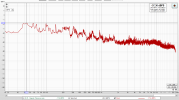Hello!
The majority of my listening is to rock music.
What F3 value should I look for in a speaker to make sure it can reproduce all the bass tones?
If the music changes to jazz or classical, would that change the recommended F3?
Thanks in advance!
The majority of my listening is to rock music.
What F3 value should I look for in a speaker to make sure it can reproduce all the bass tones?
If the music changes to jazz or classical, would that change the recommended F3?
Thanks in advance!



